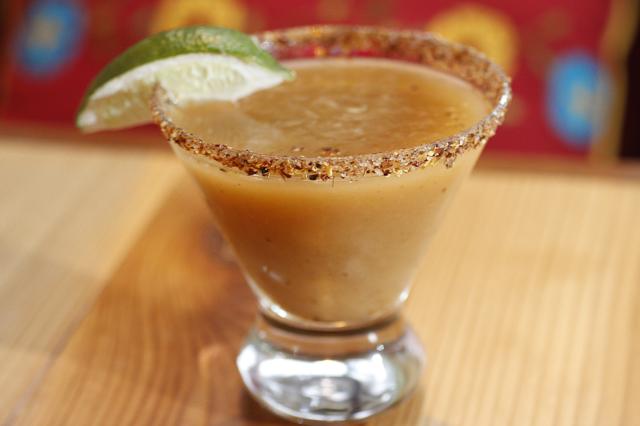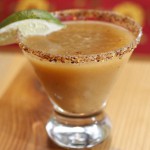- Um, waiter..? Limones in downtown Asheville serves a margarita that with a cricket-salt rim. Photo by Jonathan Welch
- Wild man: Alan Muskat in his kitchen where he cooks a bevy of wild-gathered foods, including the sauce pan of buttered termite larvae that he’s holding. Photo by Mackensy Lunsford
They account for more than two-thirds of all known earthly organisms. They're protein-rich and valued by cultures the world over. But while insects fill tacos and tamales in South America, they're mostly the stuff of nightmares here in the U.S.
Entomophagy, or the eating of insects, is regarded as a shock-value culinary exploit by some. It's a scene from Fear Factor, a challenge from Survivor. More infrequently, underground bug-eating dinners are organized by entomophagy enthusiasts. In September of last year, the New York Times featured a Williamsburg bug dinner in the pages of its dining section, painting the feasts as vehicles for personal transformation.
And while many see insect-eating as the final threshold of the daring (or disgusting) foodie, other cultures eat them out of necessity; others simply view them as a plentiful and acceptable food source. In Botswana, sun-dried mopane worms are relished for their protein content, more than three times that of beef. In Oaxaca a dish of spiced chapulines (crickets) is as common to Mexicans as a bowl of peanuts is to Americans.
Sorry, Jiminy
Hugo Ramirez, chef and owner of the Asheville Mexican-Californian restaurant Limones, grew up in Mexico. As a young adult, he moved to California to further the culinary education kick-started by his grandmother, whose recipes turn up in some of the menu’s more traditional Mexican dishes.
Ramirez recently looked into importing whole crickets (mostly because Xpress asked him to arrange a chapuline taco-tasting), but has found them difficult to source. Customers should not expect bug tacos to turn up on the menu any time soon, he says, but Limones currently offers a Maya Margarita for the aspiring entomophagist. The drink is made with Monte de Alban mezcal, tamarind juice, Cointreau — and a chapuline-salt rim.
Currently, says Ramirez, his parents can legally bring him the cricket salt from Mexico, since it's considered a prepared product, like a spice. "And that's the only way that I can get it, that I'm aware of," he says. While insect farms do exist in the U.S., many of the insects raised are farmed in order to feed pets, and aren't labeled for human consumption. In Mexico, there are rules surrounding the harvest of the chapulines, which can be found already cooked and piled high at markets, as common as bananas in the grocery store.
"Not all are edible," he says. "The ones they have in Mexico, they go and get them in the forest in certain areas and bring them to the city. Most of them come from Oaxaca and are shipped to the rest of the country."
Waiter, there’s a bug in my drink
Ramirez says that about half of the customers who order the Maya Margarita request it without the crickets. He leaves it up to the waitstaff to explain what chapuline salt means in the first place, since it's not described on the menu. “Not many people know what it really is, but I think that they like the flavor of the drink. Some customers are OK with it, and some just aren't." It's rather easy to see why some would be squeamish; though the drink is more than palatable, chapuline leg fragments are clearly visible on the rim of the glass.
Ramirez is also personally interested in sourcing whole crickets, he says, and not for the shock factor. When properly roasted, "it tastes to me like shrimp shells,” he says. “The flavor is good." Also, he says, chapulines are versatile. "Literally you can make anything you want with them," says Ramirez, who says that he's seen crickets served with molé, with beef and — a dish that would likely never fly on this side of the border — in tamales peppered with agave worms.
Termite tasting
Whether you want to accept it or not, it's nearly impossible to completely erase insects from the human diet. In fact, the USDA allows a certain amount of insect fragments in most food products — wheat flour, for example, can contain around 150 insect fragments per 100 grams before it is considered to be contaminated. As a point of comparison, in China, bugs are not contaminants, but part of the main dish — silk worm pupae is routinely wok-fried; scorpion soup is a delicacy.
Asheville’s Alan Muskat, best known for his wild-mushroom-gathering skills, doesn’t view edible insects as a nuisance. "I’m trying to eat local and harvest wild," says the Princeton-educated Muskat, who's been known to lean out of his bedroom window to harvest tent caterpillars. And what was that like? Gooey and furry, he says. "You would think it would be nasty, but it's not.” Muskat just so happens to have a jar of termite larvae and ants in his freezer on the day I visit. Why does he hold onto such things? "Anything that's edible I want to try," he says.
I'm offered a taste of the termite larvae, and I begin to get nervous only when Muskat lifts the jar of frozen worms to his nose, inhales deeply and makes an odd face. "What a strange smell," he says.
I tried the ants on a previous visit. Muskat, at the time, was trying to convince me to eat lamb heart — raw. The ants were a fine compromise; they're rather tart and acidic, similar to the flavor of sumac, a purple-tinged spice used in Middle Eastern cuisine to add a lemony taste to food. But termite larvae?
"These would probably taste better fried," says Muskat, trailing off as he discovers and removes a doodlebug from the jar of frozen termite grubs. "I'm not going to try to fool you, I don't have a rather long track record with these things, so I don't know what to do with them." Not exactly comforting talk.
Muskat’s heart is in the right place when he assumes that everything is better with butter, and fries the termite larvae in a pat or two. Despite his efforts, it's hard to claim that the termites would make a suitable meal — I likened their flavor to green wood with something oddly chemical on the finish. They’re rather tannic and, frankly, not very good. Maybe it's what they had for lunch — though it couldn't have been much stranger than what I was having. It wasn't helpful that I looked at them under a magnifying glass first.
The stuff of nightmares
Muskat's shelves are lined with books about eating wild. But nothing really seems wild about the black walnuts from the yard sitting on the table next to a jar of dried wild fruits when there are termite nymphs on the cutting board. We talk about how egg yolks from free-range chickens that feast on grubs are bright yellow-orange from antioxidants and good fats. What is it with this aversion to insects when they can be a healthy — and many say delicious — snack?
Bug-eating is simply not a part of our culture yet, he says, even with the rise of wild food gathering and daring foodies. "There's no field guide to edible insects. It's very sad that there's very little info about it,” he says. “There are field guides to insects in general and anthropological lists with Latin names of insects that people used to eat." Which is why Muskat is somewhat of a pioneer, harvesting all sorts of creepy crawlies with which to experiment.
This talk of eating caterpillars and such stirs up a bit of an unbidden, visceral reaction in me — not to mention the experience of eating the termite larvae, which I’d hoped (in vain) to enjoy. I ask Muskat if he feels that people should get over their aversion to insects. "Your first responsibility is to yourself,” he says. “When you say, 'get over it' to somebody, it doesn't really work.”
Talking taboos
When it comes to food taboos, Muskat says, our personal memories and associations run deep, and can be hard to overcome — and, if eating an insect isn't going to save you from certain starvation, there's not necessarily any reason to do it. "When I started getting used to eating raw meat and blood, I didn't push myself, really,” he says. “That's what causes trauma."
So, that’s why children in Indonesia gleefully scoop up sago palm grubs, while American children (mostly) squeal in fear. "They're foreign to us, and it's how we depict them," says Muskat. "Look at the movie Alien — the monsters look like insects."
When it comes down to it, he says, it's all about our conditioning. Some cultures regard eating cows as disgusting. Others see eating horse as being wrong on almost a moral level. That doesn't stop it from happening. "What makes something disgusting?" he asks. "What makes something wrong morally? That line can often overlap, and they both ultimately come down to what is safe. What is going to hurt me or someone else? That’s all that matters."
And often, in our culture, some of the most plentiful foods are ignored. Take the prolific — and very edible — dandelion, for example.
"What is common is disparaged," says Muskat. "We take for granted what's there. And refinement is what people often want." He cites white flour and rice as examples of natural foods that have been refined or whitewashed by our food culture. "But now, ironically, you end up paying more for whole foods, like unpolished rice."
Bugs, says Muskat, also remind us of our vulnerability. "They represent something that can slip through the cracks, in the walls that we build around ourselves, and invade our space."
And challenging those deep-seated reactions may seem too much of an effort to make for lunch, but those boundaries seem to weaken little by little. After munching on termites, finding a few Indian meal moths in my jar of arborio rice didn’t bother me so much.
— Mackensy Lunsford can be reached at food@mountainx.com





A few years ago, I read an article in Nat Geo that was on the fact that millions of dollars worth of potential thoroughbred racehorses were being still born, or born “bloody bag”. And after exhaustive research, they discovered the culprit: those soft, furry, bland, webworm caterpillars that your friend was trying out as food. As they crawled across the ground, horses would eat them while grazing, and while the adult horse wasn’t harmed, a toxin in the worms attacked the developing nervous systems of the unborn horses.If a few worms can spontaneously abort horses, what is the toxic level for humans?
If you want to try your hand — and belly — at foraging for bugs and other wild foods, check out the country’s first forage-and-eat series, April to November, right here in Asheville, at
NoTasteLikeHome.org